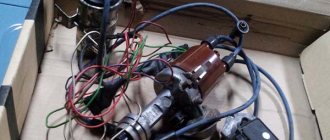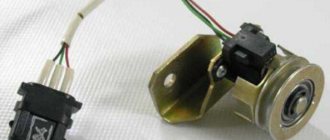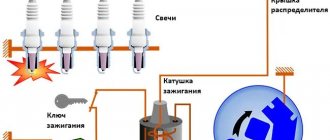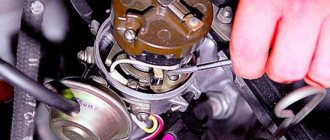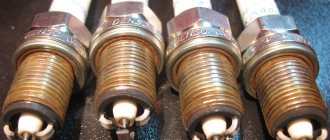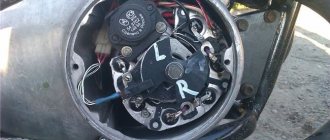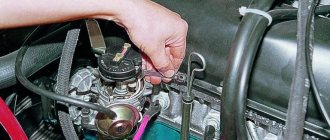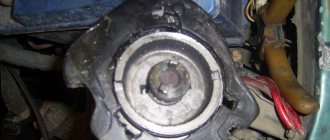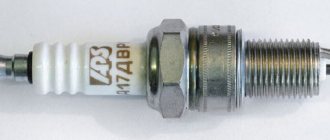The reason that prompted me to prepare this material was the constantly and with enviable regularity that pops up the question of whether it is possible to install a contactless (electronic) ignition system on the VAZ-2121, similar to the one with which the VAZ-21213 is equipped. Since at one time I myself was concerned about this problem and successfully implemented it on my car, after which I drove with contactless ignition for more than two years before replacing the engine, I believe that my experience will be useful to those who also want to carry out a similar modernization of their car.
I won’t go into too much detail about the advantages of a contactless ignition system over a conventional contact one. This has already been done well before me. Therefore, in order to avoid repetition of already known truths, I first suggest that you take a walk through the links below and read them carefully. Everything is quite complete and well presented there:
Have you read it? Well, that's great. Now I will continue.
So, let's go to the store to buy components. At the same time, let’s carefully remember the number of the contactless ignition distributor for the “classic” indicated in the above links, or even better, write it down on a piece of paper so as not to forget. This number is indicated on the distributor body. Let’s not rely on the “competence” of sellers who can easily sell you a Niva distributor, assuring you that it must be installed on a six-wheel engine.
Also, when purchasing components, it is advisable to immediately take a spare switch and Hall sensor, since these devices have the unpleasant property of suddenly and for no apparent reason malfunctioning or breaking down, after which your car can only go further in tow. Remember that the commutator and Hall sensor are VITAL SPARE PARTS THAT MUST ALWAYS BE IN YOUR CAR! If you are a master yourself, then without much difficulty you can, if necessary, replace them, and if not, then someone who knows how to do this will replace them for you, for example the same “Angels”. But for this, the switch and sensor MUST BE AT YOUR HANDS, otherwise you will have to frantically rush around either looking for them or looking for the tractor.
When purchasing a Hall sensor, make sure that it matches the distributor you are purchasing. To do this, remove the distributor cover and compare the sensors. They must be absolutely identical. In addition, the “correct” sensor should have two ears on the sides for mounting screws, and not one in front - this is a sensor, in my opinion (I don’t know for sure), for 2108. It can also be adapted to the distributor, but the description of this work is beyond the framework of the present story.
The ignition coil must be taken for the VAZ-2108. Better than the regular type, oil-filled. I don’t presume to say for sure, but there seems to be an opinion that a “dry” type coil has a number of disadvantages, due to which the use of a conventional coil seems to be preferable.
It is also worth paying attention to the wiring harness. You need to get an ignition harness for the Niva - there are some on sale. The colors of the wires in it correspond to the colors of the wires indicated in the electrical diagram 21213, so in order to know what to connect and where, you need to have this diagram with you. When buying a harness, pay attention to how well the terminals hold in the sockets of the blocks, because when putting the blocks on the connectors of the switch and Hall sensor, the terminals, under the influence of the applied force, can jump out of the sockets and the car simply will not start. It is quite advisable to somehow better fix these terminals yourself before installing the harness.
Regarding high-voltage wires, we can say that their choice is quite large. More details about this can be found in this FAQ section. I used blue Tesla silicone wires and after replacing the engine I switched them over to it. I've been traveling with them for almost three years now.
There is no need to buy an electronic control unit for the forced idle economizer (EPHH), since the carburetor 2107-1107020 “Ozone”, which is equipped with the 2106 engine, does not have an electronic control system for the idle speed solenoid valve. This block may be required only if the carburetor 2107-1107020 “Ozone” is replaced on the engine of your car with the carburetor 21073-1107010 “Solex”, which is standardly equipped with the engine 21213, and you want to equip your car with this block, so to speak, for complete set. In my opinion, this need not be done, since this unit is mainly designed to meet the environmental safety requirements of the machine, and the fuel economy obtained thanks to it can rather be considered symbolic - about 0.5 l/100 km.
But the components have been purchased and now you can start installing them. Anyone who will not do this themselves and contact a car service center may not read further, since this article is intended mainly for those who will do all the work with their own hands.
What should you pay attention to when performing work? What's important here?
1. The negative terminal from the battery must be removed.
2. When working, as already mentioned, check the electrical diagram of the VAZ-21213.
3. The best place to install the switch is the inclined part of the wall of the engine compartment, behind the battery, next to the body number (the switch should not cover the number!). Holes are drilled in this wall for self-tapping screws that will mount the switch.
4. Before removing the old distributor, remove the cover from it and look at which cylinder the contact of the slider is directed towards. We install the new distributor with the cover removed and in the same position of this contact. If this is not done, then there may be problems with starting the engine, even to the point that the engine will not start at all.
5. The wiring harness (installed last), although it is believed to be for the Niva, the part that goes to the distributor is such a length that it would probably be enough for the engine compartment of a bus. Therefore, when laying the harness, we drag it behind the air supply box, and fold the excess part 2-3 times so that the harness can freely reach the distributor, fix this fold in several places with electrical tape and screw the entire harness in 3-4 places, again with electrical tape , to the spare tire support, from its lower side. When connecting the harness, you must try to connect the terminals so that the terminals fit tightly onto the connectors, otherwise there may be problems.
But everything is mounted and connected. We start the engine and set the OZ as is done for the 2106 engine - by placing a mark on the crankshaft pulley opposite the middle mark on the front engine cover. The installation primary SOP of the 2106 engine should be 3-5 degrees.
Which ignition is better: contactless or contact?
Contact ignitions are obsolete, but are still used in older cars. On rear-wheel drive VAZ models, contactless was first installed on 2107.
Let's look at the differences between contact and non-contact ignition:
Advantages of contactless ignition:
- since there is no contact group in the distributor, sparking occurs clearly;
- long coil life;
- at medium engine speeds, BSZ creates a spark 4 times more powerful than contact ignition. This is especially useful if the spark plugs are dirty, as a spark will still be produced;
- performs its functions perfectly even in cold weather;
- if the voltage in the electrical network is low, then sparking will still occur;
- thanks to the powerful, stable spark of the candles, the fuel-air mixture ignites faster;
- if BSZ is installed, then fuel consumption decreases and engine power increases;
- improved vehicle acceleration dynamics;
- BSZ is easier to maintain because the device has no moving parts.
Non-contact ignition system device
The BSZ device for carburetor engines consists of:
- Distributor. This is a device that is responsible for creating a spark at the right moment. It is also called the ignition system distributor.
- High voltage coil. This element in the ignition system receives low voltage from the battery, converts it and supplies high voltage. Therefore, high-voltage wires come from it. The coil consists of two windings. The primary one is made of a large cross-section wire (connected to the electrical part of the car via the ignition switch relay), the secondary one is made of many turns of thin wire (connected with a high-voltage wire to the distributor).
- Switch. This element of the contactless ignition system is responsible for the formation of a spark. In simple words, a switch is a signal amplifier. The switch is only available in the ignition system of internal combustion engines with a carburetor. By the way, SOLEKS is considered the best carburetor. On injection VAZ 2107, as well as on others, a switch is not needed, since its functions are performed by the on-board computer controller.
- High voltage and normal wiring. High voltage wiring must meet heavy insulation requirements.
- Terminals. Serve for connections and must be strong.
Electronic and contactless ignition systems are the same device. It got its name due to the absence of a contact group in the system design. The ignition switch also has a contact group, which is a common cause of engine failure.
Distributor device:
- frame;
- shaft;
- cam;
- moving contact (slider).
High voltage wires
The contactless ignition system uses high-voltage wires of type PVVP-8 (red) with distributed resistance (2000±200) Ohm/m or PVPPV-40 (blue) with distributed resistance (2550±270) Ohm/m.
At one time, immediately after purchasing the Niva, I switched from contact ignition to contactless - BSZ. The car started up faster, kept the speed more stable, but... But this seemed not enough to me, I wanted something more. And I started studying Tyrnet. As a result, I selected three options for myself: 1 – conversion of the BSZ to “idle spark” type coils 2 – microprocessor ignition system (MPSZ) MAYA 3 – MPSZ SECU-3 On reflection, I refused to convert the BSZ - at the output we get the same BSZ, the only one with two coils instead of one (but with a more powerful spark, though). But at the same time, the possibility of changing the ignition angle remains the same - by turning the distributor body + bending the spring weights. Of the remaining two options, I chose SECU-3. Why ? Well, I liked this system))) So what we have: 1 - the possibility of several installation options: One coil - with spark distribution by a distributor. Two coils - “idle spark” type. Four coils - individually for each cylinder. Another option is the ignition module. Commutators - from one to four 2 - wide possibilities of system operation - the ignition angle can vary (depending on the installation configuration) taking into account engine speed, coolant temperature, engine load and engine detonation 3 - the ability to use ready-made “maps” - tables changes in the ignition angle, as well as adjustments to these tables. To make it more clear, after installing the MPSZ, I drove with standard tables on 27” tires. Confident acceleration throughout the entire range, smooth and stable acceleration without dips. But then I set the BF to 29” - the car began to “stupid” when I sharply pressed the gas. And now I need to experiment - in the speed range from 800 to 1500 I need to change the ignition timing. I can either raise it, relative to the preset one, or lower it. Make the change in angle both smooth and sharp. And all this is precisely and specifically only in the speed range that I currently need to adjust. 4 - the ability to write your own map But there is also a serious drawback - financial investments. I had to buy: MPSZ Absolute pressure sensor - DBP Coolant temperature sensor - DTOZh Crankshaft position sensor - DPKV Knock sensor - DD Coils Commutators Shielded wire Engine front cover Toothed engine pulley Well, and all sorts of little things))) In general, everything cost a pretty penny ( ((And considering that there is nothing in our stores, we had to order almost everything on the mainland. That is, pay for the delivery of all components by mail. Well, waste time on this very delivery ((( In addition, you need to program the unit from a laptop - this is also finance . You can, of course, program at home from a computer - but from a laptop it’s better. On a machine you can immediately monitor all the parameters. But now I’ve finally started installation! (I will describe it in exactly the order in which I installed it)
Electronic ignition connection diagrams: VAZ 2101-VAZ 2107
Scheme of a contactless ignition system for VAZ cars:
How contactless ignition works
The sequence and principle of operation of the BSZ is as follows:
- The driver turns the ignition key.
- The circuit is closed and constant voltage from the battery is supplied to the primary winding of the ignition coil. The energized primary winding forms a magnetic field around itself.
- When the starter starts, it begins to rotate the crankshaft of the internal combustion engine and rotates the shaft, which is located inside the distributor along with the slider.
- The hall sensor detects how the distributor shaft rotates (along the protrusion on the shaft) and transmits a signal to the switch.
- The electronic unit turns off the voltage supply to the primary winding based on the signal from the Hall sensor.
- When the voltage supply circuit is interrupted, at that moment a high voltage pulse of up to 24 kilovolts appears in the secondary winding of the coil, which is transmitted through a thick wire to the slider (the moving part of the distributor).
- Fixed contacts are built into the roof. The runner throws an impulse onto one of these stationary contacts. From the contact that received the high voltage pulse, it is transmitted through high-voltage wires to the spark plugs of those cylinders in which the pistons are at top dead centers.
- When voltage is applied to the spark plug, the working combustion chamber of the cylinder already contains fuel and air in a compressed state for ignition.
- The distributor slider rotates to spark all spark plugs according to a certain sequence pattern: 1-3-4-2. Depending on how to install the slider, the entire operation of the system depends, early ignition or later, we learned to determine in another material.
- The car engine starts.
ECMs are sometimes interchangeable, but sometimes they are not repairable.
Diagram of an outdated VAZ ignition system (without switch)
1 — distributor (distributor);
2 - breaker; 3 - capacitor; 4 — ignition coil (bobbin); 5 - battery; 6 — ignition switch; 7 - spark plugs. This scheme is in systems where there is no switch. The circuit is broken mechanically using a breaker.
Disadvantages of contact ignition:
- The contacts burn and oxidize, which reduces the power to create a spark.
- There are wear parts that are recommended to be changed every 20 thousand km. mileage
- Converted power in contact systems is up to 18 kilovolts. For electronic or contactless ones - up to 24 kilovolts.
Disadvantages of contactless ignition:
- The Hall sensor cannot be repaired. Working service life up to 50 thousand km. mileage
VAZ 21213 | Firing order
The efficiency of recoil and the overall performance of the power unit depend on the correct sequence of ignition of the air-fuel mixture in the engine cylinders - to avoid such violations, disconnect the explosive wiring one by one, carefully marking each wire.
| 90 posts on previous pages | |
| The switch does not receive voltage pulses from the contactless sensor: | Do the following: |
| – a break in the wires between the ignition distributor sensor and the switch | – check the wires and their connections; replace damaged wires |
| – contactless sensor is faulty | – check the sensor using an adapter connector and a voltmeter; faulty sensor replace |
| No current pulses are supplied to the primary winding of the ignition coil: | Do the following: |
| – a break in the wires connecting the switch to the switch or to the ignition coil | – check the wires and their connections; replace damaged wires |
| – switch is faulty | – check the switch with an oscilloscope; replace faulty switch |
| – the ignition switch does not work | – check and replace the faulty contact part of the ignition switch |
| High voltage is not supplied to the spark plugs: | Do the following: |
| – the tips of the high voltage wires are loose or oxidized; they are not seated tightly in the sockets; the wires are heavily soiled or their insulation is damaged | – check and restore connections, clean or replace wires |
| – wear or damage to the contact carbon, its hanging in the cover of the ignition sensor-distributor | – check and, if necessary, replace the contact angle |
| – current leakage through cracks or burnouts in the cover or rotor of the ignition distributor, through carbon deposits or moisture on the inner surface of the cover | – check, clean the cover from moisture and carbon deposits, replace the cover and rotor if they have cracks |
| – burnout of the resistor in the rotor of the ignition sensor-distributor | – replace the resistor |
| – the ignition coil is damaged | – replace the ignition coil |
| The spark plug electrodes are oily or the gap between them is not normal | Clean the spark plugs and adjust the gap between the electrodes |
| Spark plugs are damaged (cracked insulator) | Replace the spark plugs with new ones |
| The order of connecting high voltage wires to the terminals of the ignition sensor-distributor cover is violated | Connect the wires in firing order 1–3–4–2 |
| Incorrect ignition timing setting | Check and adjust ignition timing |
| Engine ignition too early | Check and adjust ignition timing |
| Large gap between spark plug electrodes | Check and adjust the gap between the electrodes |
| The springs of the weights of the ignition timing regulator in the ignition distributor sensor have weakened | Replace the springs, check the operation of the centrifugal regulator on the stand |
| The wires in the ignition system are damaged, the fastening of the wires is loose or their tips are oxidized | Check the wires and their connections. Replace damaged wires |
| Wear of electrodes or oiling of spark plugs, significant carbon deposits; cracks in spark plug insulator | Check the spark plugs, adjust the gap between the electrodes, replace damaged spark plugs |
| Wear or damage to the contact carbon in the ignition sensor-distributor cover | Replace the contact angle |
| Severe burning of the central contact of the ignition sensor-distributor rotor | Clean the center contact |
| Cracks, contamination or burns in the rotor or cover of the ignition distributor sensor | Check, replace rotor or cover |
| The switch is faulty - the shape of the pulses on the primary winding of the ignition coil does not correspond to the norm | Check the switch using an oscilloscope, replace the faulty switch |
| Incorrect ignition timing setting | Check and adjust ignition timing |
| Sticking weights of the ignition timing regulator, weakening of the springs of the weights | Check and replace damaged parts |
| The switch is faulty - the shape of the pulses on the primary winding of the ignition coil does not correspond to the norm | Check the switch using an oscilloscope, replace the faulty switch |
The ignition order and direction of rotation of the distributor for various models is shown in the illustrations.
Ignition order and direction of distributor rotation on models 1.5 l (4g15 engine) and 1.8 l (4g93 engine) 1993 ÷ 1996 issue
Selection of BSZ
When purchasing a new BSZ, you should pay attention to the presence of the components of the entire kit. The factory kit should contain:
- Distributor (main distributor). The code for engines 1.5 and 1.6 is 38.37061. For 1.3 engines, the number will be 38.3706–01, because the height of the 1.3 engine block is lower and the distributor shaft is shorter.
- Switch number 36.3734 or 3620.3734.
- High voltage coil (reel). Marking 27.3705
- Thin wires with connectors.
In appearance, the BSZ kit for the VAZ 2121 NIVA is very similar. But it’s better not to install this kit on a VAZ 2107 or a VAZ 2106, because the characteristics of the “six” and “seven” are very different from the “Niva”. Distributor brands for Niva: 3810.3706 or 38.3706–10.
The best manufacturer of electronic ignition systems for old VAZ cars is. The production capacity base is located in the city of Stary Oskol. According to reviews from car owners of classic BSZ SOATE models, this is an excellent option.
Peculiarities
The operation of the Niva 21213 system depends on the condition of its parts. High-voltage wires must have a distributed resistance, the value of which is in a certain range. Too much resistance will result in the ignition coil not having enough power to cause a breakdown. Low resistance increases interference. Although, some install just such wires. Of course, the spark power will increase and engine performance will improve. Spark plugs can lose their properties over time. The electrodes melt and carbon deposits appear.
The high temperature inside the cylinders greatly heats the spark plugs. Therefore, even when the ignition is turned off, ignition occurs from heated spark plugs.
It is important that all spark plugs have the correct gap between the electrodes. This will ensure high-quality ignition of the mixture. The distributor cover must be clean from dirt, since its presence can lead to current leakage.
Installation of contactless ignition for VAZ 2107, 2106
To install the BSZ with your own hands, you will need the following tools:
- Screwdrivers (flat and Phillips);
- Open-end wrenches 8, 10, 13 mm;
- Pliers (pliers);
- Candle key;
- Drill or screwdriver with a drill diameter of 3-3.5 mm. You will have to drill two holes in the body to secure the switch.
- A special wrench for rotating the crankshaft of an internal combustion engine or a regular open-end wrench of 30 mm.
An inspection hole for installing the ignition is not required. Here, in fact, is the procedure for removing the old contact ignition:
- Open the hood, disconnect the battery and disconnect the high-voltage wires from the spark plugs.
- Unscrew the spark plugs.
- Rotate the engine crankshaft until the piston in the first cylinder reaches top dead center (TDC). You can use a long screwdriver or wire to check where the piston is located. Make sure that the mark on the engine crankshaft pulley coincides with the very first long mark on the cylinder block.
- Disconnect the latches of the distributor cover and remove it with the wires. Draw a mark on the valve cover opposite the slider.
- Disconnect the hose coming from the carburetor and all distributor wires.
- Unscrew the fastening nut and remove the distributor along with the gasket.
- Unscrew the coil mounts (remember which wires are attached where) and remove it.
The procedure for installing contactless electronic ignition on a VAZ 2106-2107.
- Drill and attach the commutator next to the coil. But, do not place it under tanks with liquid.
- Remove the cover of the new distributor and put on the gasket.
- Install into the seat for the distributor so that the moving contact is opposite the drawn mark on the valve cover. Do not immediately tighten the nut all the way.
- Install the new coil where the old one was. The wires from the ignition switch relay, tachometer, and switch must be connected to the reel terminals. The wire from the electronic unit number 1 is connected to the coil terminal marked “K”, the wire from the 4th contact is connected to the coil terminal marked “B”.
- Check the gaps of the spark plugs (should be 0.8-0.9 mm) and screw them in place.
- Snap the distributor cover and connect the high-voltage wires (the central one from the coil and 4 wires to the spark plugs). We connect the wires to the spark plugs strictly in accordance with the designations.
- Connect the vacuum hose.
General tips for connecting high-voltage wires.
Checking high-voltage wires. To check the wires, you will need a multimeter tester. Check the resistance of the wires - it should be no more than 20 KOhms (in practice, the longest wire of cylinder 1 has a resistance of up to 10 KOhms). If the wire resistance is more than 20 Kom, it must be replaced. Carefully inspect the wires for chafing on parts of the motor or other wires. In case of significant abrasion, replace the wire. In case of minor abrasion, it is possible to lay the wire so that it does not rub and fix it in this position.
Laying wires. Do not try to connect the wires in a bundle. Disassemble the wiring harnesses, release the wires from the plastic holders. Connect the high-voltage leads to the corresponding cylinder spark plugs. Lay the wires so that they do not rub against each other, engine parts, or hoses. Avoid sharp bends and tension on the wires. After connecting all the wires, secure them into the bundle with special comb holders included in the delivery kit.
The procedure for connecting I/O wires to a VAZ carburetor (2108, 2109, 21099)
The central wire from the distributor cover always goes to the ignition coil (bobbin).
The outlet of the distributor cover, which faces towards the front of the car, is connected to the first cylinder.
The outlet of the distributor cap, looking down, is connected to the third cylinder.
The outlet of the distributor cap, looking rearward, is connected to the fourth cylinder.
The outlet of the distributor cap, looking up, is connected to the second cylinder.
The procedure for connecting high-voltage wires to a VAZ Classic, Niva with a carburetor and distributor.
Central wire from the ignition coil (bobbin)
1 cylinder - above the vacuum corrector. Next, clockwise, the order is 1-3-4-2.
Injection VAZ produced before 2004 with an old-style ignition module (4-pin low-voltage connector)
Actually, on the module body it is already indicated which cylinder the pins correspond to - but we duplicated them in red in case the module gets completely dirty, and you might not be able to see it in the photo.
Injection VAZ produced after 2004 with a new ignition coil (3-pin low-voltage connector)
As with the old-style ignition modules, the new coils are also marked with pins corresponding to the cylinders. But the connection order is different from the order on the old-style ignition module. Be careful.
Ignition distributor sensor 3810.3706
1 – roller; 2 – housing of the ignition sensor-distributor; 3 – latch; 4 – contactless sensor; 5 – vacuum regulator housing; 6 – diaphragm; 7 – vacuum regulator rod; 8 – support plate of the centrifugal regulator; 9 – ignition distributor rotor; 10 – side electrode;
11 – cover; 12 – central electrode; 13 – ember of the central electrode; 14 – resistor; 15 – external contact of the rotor; 16 – driving plate of the centrifugal regulator; 17 – weight of the centrifugal regulator; 18 – support plate of the contactless sensor; 19 – screen.
Installation of electronic ignition on video for classic VAZ 2101-2107 cars.
This video covers all the nuances.
How to adjust contactless ignition
Before setting the ignition on VAZ 2101-2107 cars, you need to warm up the engine a little, without letting it stall.
You can adjust either by ear or using a special device called a strobe to set the ignition.
A strobe light is a device with which even a beginner can set the ignition correctly. For more information on setting up the ignition with a strobe, watch the video.
We install ignition on a carburetor Niva VAZ 21213
It is clear to anyone, not even a car owner, that without the ignition the car will not start or drive (criminal options are not considered). Depending on the car manufacturer, repairs or replacement of parts occur at a car service center or independently. Installing the ignition on a VAZ 21213 NIVA carburetor is one of those processes that the owner can carry out himself. This approach will save money and give you personal experience in repairs.
First start
Sometimes after installing electronic ignition on a VAZ 2106, the car refuses to start. This suggests that you need to check whether everything was installed correctly. Pay attention to the connection of high voltage wires. The problem may also arise due to the fact that the slider, as a result of turning the distributor cap, began to supply an impulse not to the first, but to the fourth cylinder.
It is best to adjust the system using a strobe light. Not everyone has it available. But it’s not worth buying in a store just for once. It is best to go to a car service center and order an initial adjustment service there.
Once the contactless ignition is installed, you will feel a significant increase in driving dynamics. The engine will run smoothly and stably, fuel consumption will decrease. You will have to repair the ignition system less often. However, it would be a good idea to carry a backup Hall sensor with you just in case.
Features of replacing the ignition switch
First of all, it is important to make sure that the problem is in the lock. Therefore, the spark plugs, distributor and ignition coil are inspected. Often these parts of the internal combustion engine become the reason for failures of correct operation. If breakdowns in them are excluded, then the ignition switch (IZ) should be replaced. Removal order:
- Disconnect battery.
- Remove the steering column.
- Mark the wires going to the 3Z contact area. Using a flat-head screwdriver, unscrew the bolts securing the switch to the steering column (left and right).
- Insert the key into position 0. By pressing the screwdriver, press the lock slightly through the hole (do not touch the key).
- Lightly pull the 3Z towards you and dismantle it. The ignition switch Niva 21213 is switched off according to the wiring diagram (the contact part is changed if required). To do this, be sure to remove the retaining ring with a screwdriver.
- Remove the key, install the contact part so that the wide protrusions of the body and the parts coincide.
- The remaining parts are assembled in the reverse order.
If you strictly follow the instructions and wiring diagram, no problems should arise. This is facilitated by the simplicity of the design. Moreover, the part can even be repaired if the damage is not critical.
Design features of the Chevrolet Niva ignition switch
On VAZ-2123 cars, an ignition switch of type 2123-3704005 is used with an anti-theft locking device, a lock against re-starting the starter without first turning off the ignition, and a communication coil for the ignition key transponder with the car's anti-theft system.
Ignition switch 2123-3704005
At the ignition switch, they check the correct closure of the contacts at different key positions (see photo below), the operation of the anti-theft device and the presence of communication with the car anti-theft system.
Closing contacts at different positions of the ignition key
The voltage from the battery and generator is supplied to terminal “30”.
Connection diagram of the ignition switch with the key inserted
The locking device against reactivation of the starter must not allow the key to be turned again from position I (ignition) to position II (starter). Such a rotation should only be possible after first returning the key to position 0 (off). To unload the contacts of the ignition switch, a K6 relay is installed in the mounting block. The anti-theft locking rod should extend when the key is turned to position 0 (off) and removed from the lock. The locking rod must be recessed after turning the key from position 0 (off) to position I (ignition). The key should only be removed from the lock in position 0.
Checking the quality of the ignition switch installation
It is logical that errors are possible when connecting contacts or incorrect installation of the lock itself. Therefore, it is necessary to test the protection in the installed state. You will need an ohmmeter and a voltmeter. Performance diagnostics:
- Checking the resistance between the terminals of the secondary winding: connect the probes to cylinders 1 and 4, then to cylinders 2 and 3. The data should approximately match. An error greater than 100 ohms indicates damage to the secondary winding.
- The wiring is checked with a voltmeter. The first control - one probe is placed on contact A, the second - on ground. Start the engine and record the data. Turn off the car and repeat the procedure with contact B. The readings should be about 12 volts.
- In addition, if there is no voltage, check the fuse, the possibility of broken wiring or corrosion of the contacts.
The last case is especially unpleasant, since you will have to check almost all the wiring, contact elements, etc. If there are possible suspicions about the electrical network, it is better to take the car to a professional auto electrician. Repairing it requires a thorough knowledge of the circuit and experience in finding defects.
Setting the ignition
The last step that a car enthusiast can perform in setting up the ignition system after installing the lock. You can take the car to a specialist, but this fairly simple procedure is unreasonably expensive. Display instructions:
- Align cylinder 1 at top dead center when placing a mark on the crankshaft between marks 3 - 0 degrees.
- Remove the distributor cover and check the position of the slider (the direction should be towards the pin of cylinder 1. Using a strobe light, set the torque and then connect the battery: ground to minus, positive contact to plus.
- The regulator clamp is connected to the high-voltage cable on cylinder 1. Mark the mark on the crankshaft pulley.
- Start the engine at speeds less than 800 rpm. Direct the strobe light at the mark on the pulley. If adjusted correctly, the mark should coincide with the middle one on the engine cover.
- If the marks do not match, turn off the engine and adjust the distributor mount clockwise or counterclockwise. Then repeat the procedure.
The final check takes place on the go. You will need to warm up the engine to 80 degrees. Then accelerate to 60 km/h (or go to 4th gear, as some experts advise). Press the gas pedal sharply. If the ignition is adjusted correctly, the engine may briefly detonate.
How to adjust the ignition on a Niva with a carburetor engine with your own hands
Unpretentiousness, ease of maintenance and maintainability are a well-known advantage of all carburetor engines that were installed on cars of the VAZ family, including the entire Niva model range. But here also lies their main drawback, namely the need for periodic manual adjustments. For example, after repairs or when changing the octane number of the fuel used, the driver is required to install the ignition on a VAZ Niva car (carburetor), while injection systems do not require such manipulations.
Installing the ignition on the Niva eliminates the problem of incorrect engine operation
Due to an incorrectly set ignition timing, the engine begins to operate incorrectly and its power decreases. Timely adoption of measures to install the ignition on a VAZ-21213 Niva with a carburetor engine can eliminate the problem. If you decide to make all the adjustments yourself, you can also save on the services of a specialist. To do this, you just need to read the guide below.
Diagram: ignition system Niva 21213
On Niva 21213 cars with a carburetor engine, a contactless ignition system with a switch and a Hall sensor in the distributor is installed.
1. Generator. 2. Battery. 3. Connection block. 4. Ignition coil. 5. Switch. 6. Hall sensor. 7. Ignition distributor (distributor). 8. High-voltage wires (armored wires). 9. Ignition relay. 10. Ignition switch. 11. Spark plugs.
— To successfully operate the ignition system of a Niva 21213 car, you must constantly carry with you some of its parts, without which it will not be able to work - a switch and an ignition coil.
More articles on the electrical equipment of the Niva 21213 car
How to set up the ignition on a Niva yourself
The most accurate adjustment of the ignition 21213 (carburetor) can be performed using a strobe light. However, this is not the only method available in garage conditions, especially since many car enthusiasts do not have this device at their disposal and do not intend to buy it. Therefore, we will consider two ways to set the optimal ignition timing.
First, let's focus on adjustment using a strobe light. Prepare a “13” wrench and, in fact, the strobe itself for the upcoming work. If everything is ready, you can begin to perform the adjustment operations, following the step-by-step instructions, but first we will make a reservation that for correct adjustment the engine must be warmed up and the carburetor must be properly adjusted. So, the procedure is as follows:
To adjust the ignition correctly, the engine must be warmed up.
- First, using a special wrench to manually rotate the crankshaft, install the piston of the first cylinder so that it is at top dead center. To do this, follow the special marks that are located on the crankshaft pulley and on the timing cover. The location of the piston can be considered correct if the mark on the pulley is aligned with the middle mark on the cover.
- Next you need to remove the cover of the distributor sensor to determine whether the slider is positioned correctly. If it is directed towards the first cylinder, then the piston position corresponds to the compression stroke. If necessary, adjust the position of the slider by turning the crankshaft.
- Now you should check and, if necessary, set the optimal ignition moment of the combustible mixture - prepare a strobe light for this operation. To begin with, the device should be prepared for use by connecting its “negative” wire to the ground of the car, and the “plus” wire to the positive terminal of the battery. The sensor clamp should be connected to the high voltage contact designed to ignite the mixture in the first cylinder.
- Next, start the engine, setting the idle speed (approximately 800 rpm), and position the strobe so that its flashing beam is directed towards the mark on the crankshaft pulley. During operation, it should coincide with the middle mark on the timing cover. If alignment is ensured, then your vehicle has the correct advance angle, otherwise you will have to make an adjustment.
- With the engine running, use a wrench to loosen the sensor-distributor, then slowly turn it until the marks mentioned above match. If it is necessary to increase the angle, the distributor should be turned counterclockwise, and by turning it clockwise, you can ensure a decrease in the ignition timing. After completing the adjustment, be sure to tighten the mounting nuts.
Electrical wiring Niva 21213: features of unification
Did you like the article? Follow our channel for new ideas of useful car tips. Subscribe to us in Yandex.Zen. Subscribe.
The VAZ 21213 is the successor to the VAZ 2121 Niva, and was launched into production in 1994. The addition of a “C” in the index marked a new era of the off-road version of the car, although most of the parts were used from the entire model range of the Togliatti Automobile Plant.
In particular, the car received:
- Power unit from VAZ 2106 with volume increased to 1.7 liters;
- Two-chamber Solex carburetor;
- Contactless ignition system on a microcontroller;
- 5-speed gearbox (modified from VAZ 2121).
For reference: cars of the Niva family have become popular in many countries. A promotional video about their unique off-road qualities, like the cars themselves, can be found in Japan, Brazil, Chile and even Australia.
Switch
Switches such as 3620.3734, HIM-52 or VAT10.2 (the last two are Hungarian-made) can be installed in the contactless ignition system.
The switch is checked using an oscilloscope and a square pulse generator according to the diagram shown in Fig. 9-24. The output impedance of the generator should be 100-500 Ohms. It is advisable to use a two-channel oscilloscope. Channel 1 is for generator pulses, and channel 2 is for commutator pulses.
Rice. 9-24. Circuit for checking the switch:
1 - spark gap; 2 — ignition coil, 3 — switch; 4 - resistor 0.01 Ohm ± 1%, not less than 20 W; A - to the square pulse generator; B - to the oscilloscope
Rectangular pulses simulating sensor pulses are supplied to terminals “3” and “6” of the switch. The pulse frequency is from 3.33 to 233 Hz, and the duty cycle (the ratio of the period to the pulse duration T/Ti) is 1.5. The maximum voltage Umax is 10 V, and the minimum voltage Umin is no more than 0.4 V (Fig. 9-25, II). For a working switch, the shape of the current pulses should correspond to the oscillogram I.
Rice. 9-25. Pulse shape on the oscilloscope screen:
I—commutator pulses; II - generator pulses; A is the current accumulation time; V - maximum current value
For switch 3620.3734 with a supply voltage of 13.5 +0.1 V, the current value (V) should be 7.5-8.5 A. The current accumulation time (A) is not standardized.
For the HIM-52 switch, with a supply voltage of (13.5±0.2) V, the current value should be 8-9 A, and the accumulation time should be 8-10.5 ms at a frequency of 25 Hz. For the VAT10.2 switch at the same voltage and frequency, the current is 7-8 A, and the accumulation time is 5.5-7.5 ms.
If the shape of the switch pulses is distorted, then there may be interruptions in the new formation or it may occur with a delay. The engine will overheat and will not develop rated power.
Features of the modification
First of all, the changes affected the engine management system and control instruments. In particular:
- The wiring diagram for Niva 21213 received an additional wiring harness in the engine compartment for connecting a microcontroller and sensors;
- On the Niva model of recent years of production, a more advanced power unit with the VAZ-21214 index is installed. Instead of a carburetor, it has a fuel frame with injectors from GM. The price of a car with injection has increased because of this;
- The instrument panel has changed - the design is borrowed from the VAZ 2108 model.
Ignition system
The VAZ 21213 engine uses a non-contact ignition system consisting of:
- ignition distributor sensor (marking 3810.3706). It is responsible for creating control pulses supplied to the electronic switch;
- switch (model marking – 3620.3734) in climatic version U2.1 (corresponds to GOST 15150);
- ignition coils (marking 27.3705).
For reference: this device provides increased spark energy, which helps start the engine in cold weather, and also improves the performance of the power unit when operating the vehicle on low-quality fuel.
Dashboard
A modified instrument panel appeared on the car. In particular, instead of a voltmeter, the manufacturer installed a low battery discharge lamp (no. 12 in the diagram).
Tip: if you often operate your car in off-road conditions, you can buy and connect a voltmeter to the instrument panel yourself. It is more informative than a warning light and will allow you to identify electrical system faults long before the battery discharges.
Diagram of the VAZ-21213 car
Electrical diagram of VAZ-21213 (Carburetor). Years of manufacture: 1993-2009. The diagram shows a relay for rear fog lights, used since 2000; before that they were turned on directly from a latching switch.
1 — front lights; 2 – side direction indicators; 3 — electric motor for windshield washer; 4 — headlight washer motor*; 5 - switch; 6 – battery; 7 - starter; 8 – generator; 9 — VAZ-21213 headlights; 10 – gearmotors for headlight cleaners*; 11 – sound signal; 12 – spark plugs; 13 — carburetor limit switch; 14 — carburetor solenoid valve; 15 — ignition coil; 16 — windshield wiper gearmotor; 17 – carburetor solenoid valve control unit; 18 — ignition distributor sensor; 19 – coolant temperature indicator sensor; 20 – oil pressure warning lamp sensor; 21 – plug socket for a portable lamp**; 22 – brake fluid level warning lamp sensor; 23 – windshield wiper relay; 24 – relay for turning on the rear fog light***; 25 – relay for turning on the heated rear window; 26 – relay for turning on headlight cleaners and washer*; 27 – relay for turning on low beam headlights; 28 — relay for turning on the high beam headlights; 29 — ignition relay VAZ-21213; 30 – starter activation relay; 31 — relay-breaker for alarm and direction indicators; 32 — heater electric motor; 33 – additional resistor of the heater electric motor; 34 – backlight lamps for heater control levers; 35 – external lighting switch; 36 – main fuse block; 37 – additional fuse block; 38 – reverse light switch; 39 – brake light switch; 40 – instrument lighting regulator; 41 – ignition switch; 42 – three-lever switch; 43 – alarm switch; 44 – tailgate glass cleaner and washer switch*; 45 – heater motor switch; 46 – switch for heating the rear door glass; 47 – rear fog light switch; 48 – lamp switches located in the door pillars; 49 – interior lamps; 50 – Niva cigarette lighter; 51 – switch for the warning lamp for closing the carburetor air damper; 52 – control lamp for covering the carburetor air damper; 53 – switch for the differential lock warning lamp; 54 – parking brake warning lamp switch; 55 – sensor for level indicator and fuel reserve; 56 – instrument cluster; 57 – tailgate glass washer motor; 58 – rear lights; 59 – block for connecting additional brake lights; 60 – blocks for connecting side marker indicators; 61 – pads for connecting to the heated glass element of the tailgate; 62 – license plate lights; 63 – rear door glass wiper motor.
The order of conditional numbering of plugs in blocks:
a – windshield wipers, headlights and tailgate glass, windshield wiper relay breaker; b — ignition distributor sensor; c – relay-interrupter for alarm and direction indicators; d — switch VAZ-21213; d — three-lever switch; e — alarm switch; g – relay for turning on the rear fog light; h — rear lights (numbering of terminals in order from top to bottom); and – instrument clusters.
Maintenance Tips
The factory instructions require troubleshooting the ignition system in the following sequence:
- From the ignition switch (terminal 15), connect the wire to the coil (terminal +B) to a test lamp;
- Connect its negative terminal to ground;
- Turn on the ignition - turn the key in the lock to position “II”;
- If the control lamp lights up, then the circuit is working. If not, look for damage to the wire;
- With the ignition on, pull out the central wire from the coil from the distributor;
- Bring its metal tip to the cylinder block so that a gap of 3-4 mm forms between them;
- Turn on the starter for a few seconds;
- If the spark jumps, the coil is working.
Tip: you can quickly check the switch in one way - take it from a working car. If the car starts with the new switch, then you need to buy a new one.

